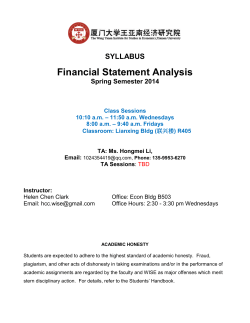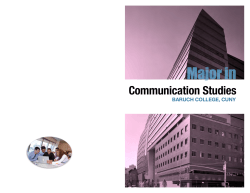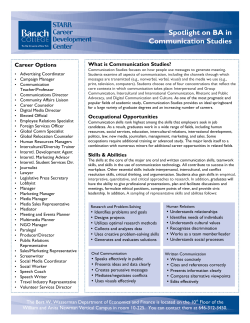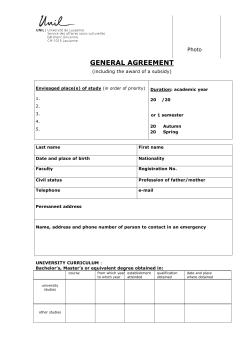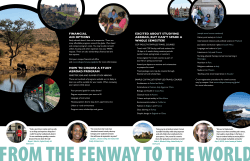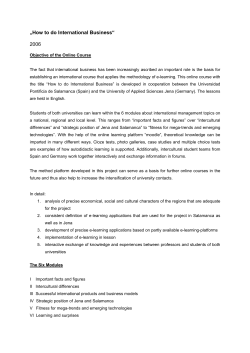
Cross-Cultural Engagement Training for Faculty: A Model for Faculty Preparation
Cross-Cultural Engagement Training for Faculty: A Model for Faculty Preparation CIEE Annual Conference, Shanghai, November 2012 Presenters: Steven T. Duke, Wake Forest University (dukest@wfu.edu) David Taylor, Wake Forest University (taylordf@wfu.edu) Michael Vande Berg, MVB Associates (mvandeberg@mvbassociates.com) Institutional Profile • Wake Forest University • Private, Winston-Salem, NC – 4730 u.g. • Six semester-long faculty-led programs, with rotating set of faculty (1-2 faculty per year) • “House” programs in London, Venice, Vienna • Direct-enroll programs in Chile, France, Spain • 15-18 summer faculty-led programs • ~ 700 students abroad, 50% on faculty-led Faculty Selection • Faculty apply to lead semester programs through the Provost Office • Faculty propose summer programs through the faculty Committee on Study Abroad • The Center for International Studies cannot hand-pick faculty to lead programs based on intercultural learning or skills, we need to work with those who are available and willing to teach abroad Faculty Training: Logistics Wake Forest faculty receive training/orientation for their responsibilities • Document on expectations of faculty • Timeline document for Communications • Health and Safety training • Mental Health training • Student Orientations • Budgets and financial aspects Quality Enhancement for SACS • In 2006, Wake Forest submitted a 10-year reaccreditation “Quality Enhancement Plan to SACS (Southern Association of Colleges and schools): “Beyond Boundaries: Preparing Students to Become Global Citizens” • Three study abroad support courses were created, and offered beginning in Fall 2007 • Goal of preparing students to become global citizens has focused on intercultural competence What was Missing for Faculty: Intercultural Preparation Faculty realized that they lacked resources and guidance on best-practices for helping students with cross-cultural learning • Faculty Study Abroad Committee always looks for cross-cultural elements, such as interaction with the locals, in new programs • “Why here?” is commonly asked • But how do we introduce culture? What are the best practices for cross-cultural engagement? Our Solution: A Workshop • WISE (Workshop on Intercultural Skills Enhancement) was created by faculty for faculty • WISE is a practitioner’s workshop intended to help faculty learn strategies and design activities that can help students develop intercultural skills and awareness • A steering committee of six faculty worked with CIS to design the content and contact speakers • WISE first offered in Feb. 2009, just six months after we started the initiative WISE as Workshop • • • • We learned a lot along the way WISE 2009 had 57 attendees Wake Forest faculty and staff could attend at no cost The workshop fee was $295 and included one night of accommodation plus dinner, coffee and snacks • WISE 2009 began at 1pm on Friday, ran through 8pm, then Saturday from 8:30 to 11:45 am • WISE 2010 increased attendance to 75 • WISE 2011 started at 9am on Friday Content of WISE • Has changed over time • The Developmental Model of Intercultural Sensitivity (DMIS) and intercultural continuum • Sessions on assessing intercultural competence, cross-cultural engagement courses, integration of language learning and cultural training, and approaches to language in non-language pgms • Sessions on mentoring while abroad, effective assignments and activities, challenges of developing countries, and risk management • Participants (‘11 and ‘12) had option of taking IDI Impact on faculty • Several faculty have implemented new activites or changed the content of their programs based on what they learned at WISE • Kathleen Macfie (UNC Greensboro) came back in 2011 to report on new efforts to have students self-reflect and blog during their program • Keith Mobley (UNC Greensboro) create a journaling template for structuring reflection and guiding activities; he also focused more time on group dynamics and processing of activities Impact on study abroaders • Brett Krutzsch (NYU) reported: “I returned from WISE with new information about making crosscultural awareness, cultural adjustment and identity reflection key components of the study abroad pre-departure process and with ideas on how to get others at my institution on board. We have begun to restructure our pre-departure curriculum so that our focus is not just logistics, but heavily about self-reflection and preparing for cultural immersion.” WISE 2013 as Conference • Beginning in February 2013, WISE will turn into a professional conference • We recognized the need to include more perspectives and voices than workshop allowed • WISE 2013 received 16 proposals, of which 12 were accepted, plus 12 invited presentations • More voices will be heard, and more folks who work abroad will present • Faculty who teach abroad and study abroad professionals are invited to attend WISE 2013 • Website: http://cis.wfu.edu/wise • Held February 1-2, 2013, in Winston-Salem, NC • Mick Vande Berg will do pre-conference workshop on January 31, 8 am - 5 pm • Film screening on January 31, 7 pm • Held in the Marriott Hotel, which has an excellent conference center • Registration is open, early bird thru Nov 30 Next Steps at WFU • Goal to work more actively with faculty, to look at their program activities and coach them more consciously about cross-cultural activities • Hold group faculty discussions 2-3 times per semester to discuss common study abroad challenges • Work with 2-3 faculty to implement research elements into their summer 2013 programs, such as the IDI and observation of student competency (not self report of impact) Resources on display Resources on display • WISE brochures • WISE programs and three-ring binders (2011 and 2012) • Syllabi of WFU’s Cross-Cultural Engagement courses WISE: an historical context • A century of study abroad • Three stories about student learning First story: students learn through being exposed to diversity and difference “out there” • Students abroad learn through contact with the new and different. First Story: Students learn through educators informing them about the new and different • Teachers deliver information about new places & people to willing recipients: information transfer Our second story: students learn through “immersion” in the new and different Second story: educators structure the learning environment so students are immersed in their experiences with diversity Common Immersion Strategies • Lengthen duration of diversity experience • Directly enroll students in university courses • Take steps to maximize student contact with host nationals • Take steps to improve students’ second language proficiency • Have students do “experiential” activities: Internships, etc. • House students with families or host students But story 2 has problems: most learners don’t respond as predicted to being “immersed” Considerable disciplinary evidence undermines the third story’s account of human learning • • • • • • • • • • The History of Science (Kuhn) Experiential learning theory (Dewey, Piaget, Kolb) Organizational Behavior (Hofstede, Trompenaars) Psychology (Piaget, Lewin, Kelly, Savicki) Scholarship of Teaching & Learning (Fink, Weimer) Cultural Anthropology (Boas, Hall, La Brack) Linguistics (Sapir, Whorf) Intercultural Relations (Bennett, Bennett, Hammer) Neuroscience (Zull) Cognitive Biology (Maturana, Varela) Vande Berg, M., Paige, R. M., & Lou, K. H. (Eds.) (2012). Student learning abroad: what our students are learning, what they’re not, and what we can do about it. Sterling, VA: Stylus. Georgetown study* and other empirical research challenge effectiveness of “immersion” practices Which immersion conditions predict Intercultural development? • • • • • • • • Duration of experience abroad: SMALL IMPACT Homestays: NO Direct enrollment in host university courses: NO Unfacilitated “Experiential” activities: NO Maximizing contact with host nationals: NO Improving foreign language proficiency: NO Pre departure cultural orientation: SMALL IMPACT Homestays—when students engage w/ host fam. member: YES • Cultural Mentoring on Site: YES Vande Berg, M. (2009). Intervening in student learning abroad: A research-based inquiry. (M. Bennett, Guest Ed.) Intercultural Education, Vol. 20, Issue 4, pp. 15-27. *Vande Berg, M.; Connor-Linton, J.; & Paige, R. M. The Georgetown Consortium Study: Intervening in student learning abroad. Frontiers: the Interdisciplinary Journal of Study Abroad. Vol. XVIII, pp. 1-75. * Our third tale: How we frame an event determines “what it means” Third tale: Learning starts as we reflect on our own ways of framing, and on our and others’ differing ways of creating knowledge • “We know what we perceive; we don’t know what we don’t perceive. Since there is no way that we can know what we don’t perceive, we assume that we perceive ‘correctly.’” (Marshall Singer) • “We do not see, that we do not see.” (H. Maturana & F. Varela) • “People don’t learn from experience; they learn through reflecting on experience.” (Thiagi) Third tale: immersion in difference, reflection on framing, & frame shifting = learning • Learning does not occur, then, simply through exposure to, or immersion in, experience • Instead, we begin to learn as we become aware of how we typically frame our experiences: “We don’t see things as they are, we see things as we are.” (Anias Nin) We help our students develop by focusing on four basic intercultural skills Increasing cultural and personal self awareness; Increasing awareness of others within their own cultural and personal contexts; Learning techniques for “bridging cultural gaps”— which is to say, interacting with culturally different others in effective and appropriate ways; Cultivating emotional intelligence—developing the capacities to identify, manage, communicate and apply emotions effectively and appropriately. WISE: Embracing the third story’s account of student learning • Recognition that the most important predictor of student learning is the extent to which educators are interculturally developed. • Not only a focal point for discussing the intercultural needs of students, but a model for the intercultural training of faculty and staff • Awareness of the critical importance of assessing the intercultural development of students, faculty and staff
© Copyright 2025
